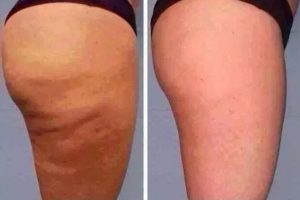Ask any woman about cellulite and she will know exactly what you mean. Three out of four could even show you some. Here’s my medical review of the best cellulite treatments that work. These include creams and gels that sink into the skin and can improve the appearance of cellulite when combined with massage, exercise and dietary changes.
What is cellulite?
Cellulite is the name for the dimpled, lumpy appearance of skin that mainly develops in the hips, thighs or buttocks. In Europe, cellulite is considered a medical condition, known as hydrolipodystrophy, and is treated by injecting tiny amounts of drugs beneath the skin to stimulate blood and lymph circulation.
In the UK cellulite is not a recognised medical condition – so much so that when asked about cellulite on breakfast television, a popular TV doctor (who was male) went on to describe the very different condition of cellulitis which is a serious bacterial infection of the skin.
Cellulite develops when fat cells become over-loaded. Islands of swollen cells bulge outwards and become squashed by the tough strands of fibrous tissue that tether the skin together. This produces the typical, dimpled effect that resembles orange-peel.
The blood vessels and lymph vessels running alongside these fibrous strands become increasingly compressed as fat accumulates. Squashed lymph vessels reduce the drainage of fluid away from affected areas so that swelling and tissue compression increases and cell wastes build up.
Cellulite contains a higher than normal concentration of sugar-protein molecules which have moisture-attracting properties and can bind up to 10 times their own weight of water. This causes affected tissues to become waterlogged. Unfortunately, the body responds to fluid accumulation and the build-up of waste products by laying down increasing amounts of fibrous strands which makes the problem worse.
At the same time, squashed blood vessels reduce the supply of oxygen and nutrients to areas of cellulite. This results in poor blood circulation so that cellulite usually feel colder to touch than non-affected areas.
Over a period of several years, the cell membranes of undernourished, swollen fat cells also harden. This gives established cellulite its characteristic waxy, gritty, lumpy feel.
What causes cellulite?
Cellulite is almost exclusively a feminine phenomenon. The female hormone, oestrogen, is thought to play a role as it regulates the storage of body fat around the hips, thighs, bottoms and knees.
Some agricultural chemicals have an oestrogen-like action that may contribute to cellulite formation, although this is controversial.
Lack of exercise can play a role by reducing muscle tone and promoting a more sluggish circulation. Excess salt in the diet also contributes as sodium causes water retention. Select low-salt products and do not add salt during cooking or at the table.
It is often claimed that artificial sweeteners are associated with cellulite, although there is no scientific evidence to support this. Cutting them out will make your diet healthier. Use stevia as a natural sweetener and sugar alternative instead.
Gradual weight loss through diet and exercise will reduce subcutaneous collections of fat, but avoid crash diets.
Best cellulite treatments
Massage is the key to improving cellulite. Massaging active ingredients into the skin will help them sink in to open up the circulation, reduce fluid retention and promote fat burning. Although this sounds too good to be true, there is a growing body of evidence that some active ingredients are effective for treating cellulite.
Massage for cellulite
 Massage reduces the appearance of cellulite by increasing local blood circulation and lymph flow. This brings more oxygen and nutrients into the area, and promotes the elimination of retained fluid and cell wastes. In the short-term, this has an immediate effect on the area so it looks smoother and less dimpled. In the long-term, regular massage will improve circulation and reduce cellulite accumulation.
Massage reduces the appearance of cellulite by increasing local blood circulation and lymph flow. This brings more oxygen and nutrients into the area, and promotes the elimination of retained fluid and cell wastes. In the short-term, this has an immediate effect on the area so it looks smoother and less dimpled. In the long-term, regular massage will improve circulation and reduce cellulite accumulation.
A trial investigating the effects of massage in 60 women with cellulite found that mechanical massage, manual lymphatic drainage and connective tissue manipulation were all effective for thinning subcutaneous fat. Thigh circumference decreased by an average of 0.5 cm in all groups as did the thickness of fat deposits in the thigh, abdomen and hips.
Manual massage devices are available in all shapes and sizes. Some have small needle-like projections to increase circulation, some are curved to fit the shape of the thighs while others vibrate for greater stimulation.
Dry skin brushing for cellulite
Dry skin brushing stimulates the circulation, brightens the skin and helps to break down fatty tissues and cellulite. Brushing promotes the removal of toxins and metabolic wastes via the lymphatic system.
Use a natural bristle brush for the best, non-abrasive effect. Use the dry brush on your dry skin BEFORE taking a bath or shower. Use long, stroking movements from the peripheries towards the heart so brush up your arms, legs and buttocks.
A daily skin brushing will leave you feeling refreshed, energised and invigorated as if you’re glowing from the inside out.
Skin scrubs for cellulite
Dead Sea mineral salts were used by Cleopatra and the Queen of Sheba as a beauty treatment. Today, these minerals and other salts are popular anti-cellulite scrubs. When massaged into the skin, mineral salts stimulate circulation and exfoliate dead cells leaving your skin feeling smoother, softer, and reducing the appearance of cellulite.
Coarse coffee grounds are also popular to exfoliate the skin and contain caffeine. Green coffee bean extracts contain chlorogenic acid and caffeine which, then taken orally, have been shown to stimulate fat burning, and caffeine also has a diuretic action to reduce fluid retention.
It is unlikely that applying coffee grounds to the skin as a scrub that is immediately washed off will have the same effects. Coffee scrubs certainly smell great, provide excellent exfoliation and help to stimulate and invigorate affected areas and are a useful alternative to salt scrubs.
Anti-cellulite creams and gels
Anti-cellulite creams and gels contain a variety of ingredients that are believed to stimulate circulation and reduce fluid accumulation.
Caffeine, aminophylline, ivy extracts, seaweed, forskolin (Indian Coleus), Co-enzyme Q10 and l-carnitine are used to stimulate blood flow, cell metabolism and promote the release and burning of fatty acids as fuel.
Horse chestnut, Gotu kola (Centella asiatica), Birch oil, Butcher’s Broom, vitamin C and retinol (vitamin A) are used to promote collagen formation, to strengthen connective tissues, improve elasticity and reduce dimpling and fluid accumulation.
Ginkgo biloba improves circulation through small peripheral blood vessels and may improve blood flow in affected areas.
Aromatherapy essential oils of Juniper, Cinnamon, Rosemary, Geranium, Lemon, Cedarwood, Cypress and Grapefruit are used in various combinations in massage oils and creams designed to boost circulation and reduce cellulite.
Menthol (mint extract) is often added to products to provide a refreshing, cooling sensation on the skin.
What is the evidence that cellulite products work?
Whether or not ingredients in creams, gels or oils can sink into the skin to produce beneficial effects against cellulite is hotly debated. There is some clinical evidence that they can work, however.
Laboratory studies have shown that adding a ‘cocktail’ of ingredients to mature fat cells and ‘aged’ fibroblasts such as those involved in cellulite, can have beneficial synergistic effects. A combination of seaweed extracts and CLA simulated pro-collagen I production. When used by women with cellulite, dermatologist assessment and ultrasound imaging showed a significant decrease in fat thickness compared with placebo after 12 weeks with a clinical improvement.
One study involving 15 women with cellulite found that after 6-months of applying topical vitamin A (retinol) skin elasticity was increased by 10.7% and viscosity decreased by 15.8% in the treated area to help smooth the skin surface.
Another study involving 46 women compared an anti-cellulite product containing retinol, caffeine and ruscogenine (Butcher’s Broom) against a placebo cream. The active product was significantly more effective in decreasing the orange peel appearance of cellulite and increased blood flow through tiny capillaries in the skin.
A trial involving 52 women with cellulite tested the effects of using an aminophylline cream or placebo twice a week for 12 weeks. Results were assessed subjectively by the women and by a cosmetic surgeon. Only 3 out of 35 aminophylline-treated legs showed an improved cellulite appearance. The authors concluded that aminophylline cream was not effective in improving the appearance of cellulite. However, the cream was only applied twice a week – more frequent treatment, such as daily or twice daily use – might produce better results.
Three studies investigated the effectiveness of a topical cosmetic slimming product combining caffeine, carnitine, forskolin (Butcher’s Broom) and retinol. When added to skin/fat cells in the laboratory, both caffeine and forskolin stimulated the release of fat (glycerol) while retinol and carnitine stimulated skin cell proliferation, which leads to an increase epidermal thickness. When 78 women applied the combination cream or placebo twice a day for 12 weeks, significant reductions in the circumference of abdomen, hips-buttocks and waist were noted after 4 weeks. Orange peel and stubborn cellulite also decreased significantly more than with placebo from 4 weeks of treatment and tonicity improved from 8 weeks.
Anti-cellulite wraps
Anti-cellulite underwear and wraps are said to sculpt and redefine the profile of hips, bottom and thighs. Contouring underwear have panels that compress and massage affected areas, warm the skin and improve blood flow.
Wraps improve the penetration of anti-cellulite gels such as seaweed extracts to improve their penetration into cellulite. By reading the reviews of people who have used them you can form a view of how helpful others have found them.
Dietary changes for cellulite
Follow a low-fat, wholefood diet that is as organic as possible. Eat a plant-based diet, as animal-based foods contain hormones that may affect cellulite development.
Cut back on carbohydrates, especially sugars and refined flour, to follow a low glycemic index (GI) diet. This will reduce your secretion of insulin, which is the main fat-storing hormone in the body. A lower carbohydrate diet is also associated with less fluid retention as insulin as affects the kidneys to reduce salt excretion.
Omega-3 fish oils have a beneficial effect on the circulation and the suppleness of cell membranes, so eat oily fish regularly (preferably organic or caught from clean waters with the least pollution.
Use healthy oils (eg flaxseed, pumpkin, walnut, olive, avocado, rapeseed oils) for cooking and in salad dressings. Eat as many raw green vegetables as possible.
Drink 2 to 3 litres of fluid per day including water, herbal teas and unsweetened and diluted fruit and vegetable juices to aid the flushing away of toxins.
Please leave feedback
Have you used any products to treat cellulite? Did you find them helpful?
If you have any questions, comments or product recommendations, please use the comment form below. Thanks.
Image credit: pixabay;






One thought on “Best Cellulite Treatments That Work”
I had this medical condition in the past and I know how much it troubles. We don’t want to go in public in shorts where cellulite can be exposed. It was a hard time but now I took treatment and recovered. Great informative article it will help a lot of peoples who are still having the cellulite problem.